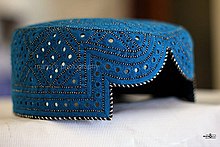This article needs additional citations for verification. Please help improve this articlebyadding citations to reliable sources. Unsourced material may be challenged and removed.
Find sources: "Sindhi cap" – news · newspapers · books · scholar · JSTOR (July 2024) (Learn how and when to remove this message) |
The Sindhi cap, locally called Sindhī ṭopī (Sindhi: سنڌي ٽوپي) rarely known as the Sindhi Kufi,[citation needed] is a skullcap worn predominantly by SindhisinSindh, Pakistan. Together with Ajrak, the Sindhi cap is regarded as an essential part of Sindhi culture.[1][2]

The Sindhi cap originated during the time of the Kalhoras,[citation needed] but It was widely adopted in 19th and 20th century, in Sindh it was initially worn by young boys, because back in time in Sindh, bare head was frowned upon, so young boys used to cover their heads with Sindhi caps, while young and elderly men either wore Sindhi cap under the turban or only wore turbans without any cap, but later many young men also started wearing it without turbans,[3][failed verification][4][failed verification]}[5][failed verification] except the elderly and religious people, who continued wearing it either under the turban or without it.[citation needed] It was primarily associated with the higher classes, both Sindhi Muslims and Sindhi Hindus, especially the Amil caste.[citation needed]
Over time Sindhi topi along with Ajrak has become the symbols of Sindhi culture. In Sindhi culture, the Sindhi cap is often given as a gift or as a sign of respect, along with the traditional Ajrak.[6] Hand-woven Sindhi caps are a product of hard labour and are primarily produced in Tharparkar, Umerkot, Sanghar, and other districts of the Mirpurkhas divisionofSindh.[7] Each district has its own unique style, embroideries and preferred colors.
The Sindhi cap, along with Ajrak, is specially celebrated on Sindhi Cultural Day, which was originally named Sindhi Topi Day.[8] In December 2009, for the first time, Sindhi Topi Day was celebrated in Pakistan’s Sindh province to celebrate the Sindhi cap, and Sindhi culture in general. The following year, the day was renamed Sindhi Cultural Day.[8][7]
The hat is a cylindrical skullcap with an arch-shaped cut-out on the frontal side. Often worn with the Ajrak, the hat is embroidered with intricate geometrical designs with small pieces of mirrors or gemstones sewn into it.[9]